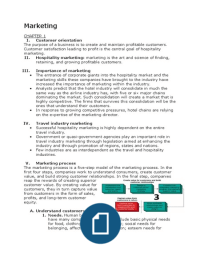Marketing
CHAPTER 1
I. Customer orientation
The purpose of a business is to create and maintain profitable customers.
Customer satisfaction leading to profit is the central goal of hospitality
marketing.
II. Hospitality marketing: marketing is the art and science of finding,
retaining, and growing profitable customers.
III. Importance of marketing
The entrance of corporate giants into the hospitality market and the
marketing skills these companies have brought to the industry have
increased the importance of marketing within the industry.
Analysts predict that the hotel industry will consolidate in much the
same way as the airline industry has, with five or six major chains
dominating the market. Such consolidation will create a market that is
highly competitive. The firms that survives this consolidation will be the
ones that understand their customers.
In response to growing competitive pressures, hotel chains are relying
on the expertise of the marketing director.
IV. Travel industry marketing
Successful hospitality marketing is highly dependent on the entire
travel industry.
Government or quasi-government agencies play an important role in
travel industry marketing through legislation aimed at enhancing the
industry and through promotion of regions, states and nations.
Few industries are as interdependent as the travel and hospitality
industries.
V. Marketing process
The marketing process is a five-step model of the marketing process. In the
first four steps, companies work to understand consumers, create customer
value, and build strong customer relationships. In the final step, companies
reap the rewards of creating superior
customer value. By creating value for
customers, they in turn capture value
from customers in the form of sales,
profits, and long-term customer
equity.
3
A. Understand customers
1. Needs. Human beings 5
have many complex needs. These include basic physical needs
for food, clothing, warmth, and safety; social needs for
belonging, affection, fun and relaxation; esteem needs for
, prestige, recognition, and fame; and individual needs for
knowledge and self-expression.
2. Wants. Wants are how people communicate their needs.
3. Demands. People have almost unlimited wants but limited
resources. They choose products that produce the most
satisfaction for their money. When backed by buying power,
wants become demand.
4. Market offerings. Some combination of tangible products,
services, information, or experiences that are offered to the
market.
5. Value, expectations, and satisfaction.
Customer value is the difference between the benefits that
the customer gains from owning and/or using a product and
the costs of obtaining the product.
Customer expectations are based on past buying
experiences, the opinions of friends, and market information.
Satisfaction with a product is determined by how well the
product meets the customer’s expectations for that product.
B. Exchange and relationships
Exchange. The act of obtaining a desired object from someone
by offering something in return.
Relationship marketing. Focuses on building a relationship
with a company’s profitable customers. Most companies are
finding that they earn a higher return from resources invested in
getting repeat sales from current customer than from money
spent to attract new customers.
Designing customer-driven marketing strategy. Marketing
management is the art and science of choosing target markets
and building profitable relationships with them.
o Selecting customers to serve. The company must select
those market segments it wishes to serve.
o Choosing a value proposition. The company must also
decide how it will serve targeted customers, how it will
differentiate and position itself in the marketplace. A
company’s value proposition is the set of benefits or values
it promises to deliver to consumers to satisfy their needs.
VI. Five marketing management philosophies
1. Production concept. Holds that customers will favour products
that are available and highly affordable, and therefore management
should focus on production and distribution efficiency.
2. Product concept. Holds that customers prefer existing products
and product forms, and the job of management is to develop good
versions of these products.
3. Selling concept. Holds that consumers will not buy enough of the
organization’s products unless the organization undertakes a large
selling and promotion effort.






